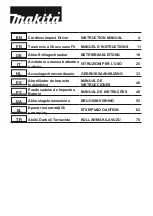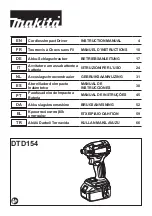
18. DRAIN COMPRESSOR EVERY DAY. Do not allow moisture to build up inside the compres-
sor. Do not allow compressor to sit pressurized for longer than one hour.
19. MAKE SURE ALL EQUIPMENT IS RATED TO THE APPROPRIATE CAPACITY. Make
sure that the regulator is set at least 10 PSI lower than the lowest rated piece of equipment
you are using.
20. DO NOT USE OXYGEN, COMBUSTIBLE GASES, OR BOTTLED GASES AS A POWER
SOURCE. The tool may explode, possibly causing injury.
21. DO NOT EXCEED the recommended air pressure of 90 PSI.
22. TOOL MUST NOT HOLD PRESSURE WHEN AIR SUPPLY IS DISCONNECTED. If a
wrong fitting is used, the tool can remain charged with air after disconnecting and thus will
be able to cycle after the air line is disconnected possibly causing injury.
23. ALWAYS DISCONNECT AIR SUPPLY: Before making adjustments, when servicing the
tool, when clearing a jam, when tool is not in use, or when moving to a different work area,
as accidental actuation may occur, possibly causing injury.
24. DISCONNECT POWER. Unplug compressor when not in use.
25. OUTDOOR EXTENSIONS CORDS. When the equipment is operated outdoors, use only
extension cords intended for outside use. See chart under “Extension Cords” for the proper
AWG rating depending on the length of the cord(s) being used.
26. DO NOT ABUSE THE POWER CORD. Do not yank it to disconnect it from the receptacle.
Do not carry tools by the cord.
27. GUARD AGAINST ELECTRIC SHOCK. Prevent body contact with grounded surfaces such
as pipes, radiators, ranges, and refrigerator enclosures.
Page #4 -- SKU: 33567
REV 12/02
For technical questions, please call 1-800-444-3353.


































